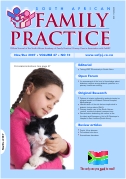Peptic ulcer disease
Abstract
Peptic ulcer disease usually occurs in the stomach and proximal duodenum. The predominant causes in the United States are infection with Helicobacter pylori and use of non-steroidal anti-inflammatory drugs. Symptoms of peptic ulcer disease include epigastric discomfort (specifically, pain relieved by food intake or antacids and pain that causes awakening at night or that occurs between meals), loss of appetite, and weight loss. Older patients and patients with alarm symptoms indicating a complication or malignancy should have prompt endoscopy. Patients taking non-steroidal anti-inflammatory drugs should discontinue their use. For younger patients with no alarm symptoms, a test-and-treat strategy based on the results of H. pylori testing is recommended. If H. pylori infection is diagnosed, the infection should be eradicated and antisecretory therapy (preferably with a proton pump inhibitor) given for four weeks. Patients with persistent symptoms should be referred for endoscopy. Surgery is indicated if complications develop or if the ulcer is unresponsive to medications. Bleeding is the most common indication for surgery. Administration of proton pump inhibitors and endoscopic therapy control most bleeds. Perforation and gastric outlet obstruction are rare but serious complications. Peritonitis is a surgical emergency requiring patient resuscitation; laparotomy and peritoneal toilet; omental patch placement; and, in selected patients, surgery for ulcer control. Permission from the AAFP was granted to publish this article in the hardcopy only. Kindly refer to www.aafp.org or subscribe to the hardcopy of South African Family Practice.
Section
CPD
By submitting manuscripts to SAFP, authors of original articles are assigning copyright to the South African Academy of Family Physicians. Copyright of review articles are assigned to the Publisher, Medpharm Publications (Pty) Ltd, unless otherwise specified. Authors may use their own work after publication without written permission, provided they acknowledge the original source. Individuals and academic institutions may freely copy and distribute articles published in SAFP for educational and research purposes without obtaining permission.

